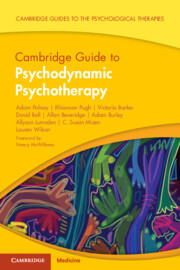Book contents
- Cambridge Guide to Psychodynamic Psychotherapy
- Cambridge Guides to the Psychological Therapies
- Reviews
- Cambridge Guide to Psychodynamic Psychotherapy
- Copyright page
- Dedication
- Contents
- Foreword
- Preface
- A Note from the Series Editor
- Acknowledgements
- Part 1: An Overview of the Model
- Part 2: The Model of Psychodynamic Psychotherapy into Practice
- Part 3: Application for Mental Health Presentations
- Part 4: Application of Psychodynamic Psychotherapy in Different Populations and in Different Settings
- Glossary of Terms
- Index
- References
Chapter 16 - An Introduction to the Dynamics of Anger, Aggression, and Violence
from Beyond 1:1 Therapy: Working Psychodynamically with Clinicians, Teams, and Organisations
Published online by Cambridge University Press: 25 August 2023
- Cambridge Guide to Psychodynamic Psychotherapy
- Cambridge Guides to the Psychological Therapies
- Reviews
- Cambridge Guide to Psychodynamic Psychotherapy
- Copyright page
- Dedication
- Contents
- Foreword
- Preface
- A Note from the Series Editor
- Acknowledgements
- Part 1: An Overview of the Model
- Part 2: The Model of Psychodynamic Psychotherapy into Practice
- Part 3: Application for Mental Health Presentations
- Part 4: Application of Psychodynamic Psychotherapy in Different Populations and in Different Settings
- Glossary of Terms
- Index
- References
Summary
This chapter starts by considering anger and the various routes to this feeling. We discuss how anger can be a desperate call to be attended to and a powerful invitation to neglect. We then discuss aggression and violence, including the potential role of shame and humiliation. At times, violence may accompany a process of an individual projecting unwanted, intolerable, or overwhelming feelings into another person. At other times, violence may be understood more in the context of fighting a perceived danger. We take inclusive approach to contemporary theory, noting that more than one approach may be useful when trying to understand a person’s actions. We touch on wider societal responses to violence, acknowledging that this is a potentially divisive area associated with strong feelings. The dynamics of anger, aggression, and violence are not necessarily straightforward to make sense of, and it is easy for any of us to inadvertently become drawn into responses that may make a situation worse. Conversely, with an awareness of key dynamics and time to reflect on these, professionals and teams can find an understanding of angry, aggressive, or violent encounters, which is a prerequisite for safe practice, working matters through, and resisting harms.
Keywords
Information
- Type
- Chapter
- Information
- Cambridge Guide to Psychodynamic Psychotherapy , pp. 244 - 257Publisher: Cambridge University PressPrint publication year: 2023
